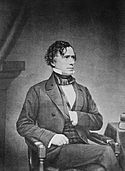Caleb Cushing
 | |
| Data i miejsce urodzenia | 17 stycznia 1800 |
|---|---|
| Data i miejsce śmierci | 2 stycznia 1889 |
| ambasador w Hiszpanii | |
| Okres | od maja 1874 |
| Przynależność polityczna | |
| Poprzednik | |
| Następca | James Russell Lowell |
| prokurator generalny USA | |
| Okres | od marca 1853 |
| Poprzednik | |
| Następca | |
Caleb Cushing (ur. 17 stycznia 1800 w Salisbury, zm. 2 stycznia 1889 w Newburyporcie) – amerykański polityk i dyplomata.
Życiorys
Urodził się 17 stycznia 1800 roku w Salisbury[1]. Ukończył studia na Uniwersytecie Harvarda, a następnie studiował nauki prawne i został przyjęty do palestry[2]. W latach 1823–1829 i 1833–1835 zasiadał w legislaturze stanowej Massachusetts[2]. W 1834 został wybrany do Izby Reprezentantów, początkowo z ramienia antyjacksońskiego skrzydła Partii Demokratyczno-Republikańskiej, a następnie – Partii Wigów[2]. W 1842 roku nie ubiegał się o reelekcję, a rok później John Tyler mianował go posłem pełnomocnym w Chinach[1]. W trakcie kadencji negocjował traktat o żegludze i handlu z Japonią[1]. Po zakończeniu misji dyplomatycznej w 1845 roku, ponownie został członkiem legislatury stanowej. W czasie wojny z Meksykiem służył jako dowódca stanowego regimentu i dosłużył się stopnia generała brygady[2]. W 1847 i 1848 roku bezskutecznie ubiegał się o funkcję gubernatora Massachusetts[2]. W latach 50. XIX wieku zasiadał w legislaturze stanowej, pełnił funkcję burmistrza Newburyportu i sędziego stanowego Sądu Najwyższego[2]. W 1853 roku Franklin Pierce powołał go na stanowisko prokuratora generalnego, które piastował do końca kadencji prezydenckiej w roku 1857[1]. Widząc groźbę secesji, wsparł Partię Republikańską i Abrahama Lincolna[1]. Po wojnie secesyjnej Andrew Johnson mianował go komisarzem ds. kodyfikacji prawa federalnego[2]. Pod koniec lat 60. XIX wieku negocjował traktat o Przesmyku Panamskim[2]. W 1872 Ulysses Grant mianował go delegatem przed Trybunałem Arbitrażowym w Genewie, by rozstrzygnąć roszczenia Alabamy[1]. Dwa lata później otrzymał nominację do Sądu Najwyższego, jednak nie otrzymał aprobaty Senatu[2]. Został wówczas powołany na posłem pełnomocnym w Hiszpanii, którym pozostał do 1877 roku[1]. Zmarł 2 stycznia 1889 roku w Newburyporcie[1].
Przypisy
Media użyte na tej stronie
Logo of the United States White House, especially in conjunction with offices like the Chief of Staff and Press Secretary.
Portrait of Franklin Pierce (1804–1869), 14th president of the United States. Pierce, a Democrat, served from 1853 to 1857 and was rejected by his party for a second term; his major acts as president include the Gadsden Purchase and the Kansas–Nebraska Act. The image is part of the Brady–Handy Photograph Collection of the Library of Congress. The entry describes it as a "Copy neg. from original ink by Brady after Daguerreotype".
Signature of Massachusetts politician Caleb Cushing.
Seal of the United States Department of Justice.
The origins of the seal are unknown; it was first used in the 19th century as the seal for the Office of the Attorney General (prior to the formation of the Department of Justice) but the exact date is unknown. Even the translation of the Latin motto is murky, a matter of debate between Latin scholars. The Department's currently accepted translation is who prosecutes on behalf of Lady Justice, referring to the Attorney General. The motto is an allusion to the wording of the writ in a qui tam action: qui tam pro domino rege quam pro se ipso sequitur ("he who sues on behalf of our lord the King as well as for himself." The current-day seal dates from 1934, when some (though not all) of the heraldic mistakes on the original were corrected. More information here.






